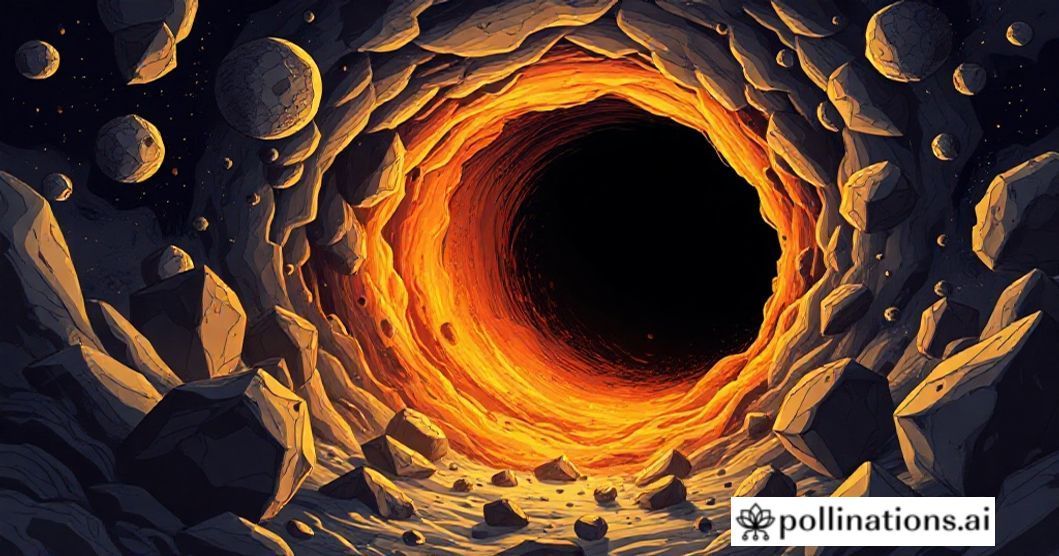black hole morsels – We know gravity as the force that keeps our feet on the ground and makes things fall ‘down’. It also keeps the moon orbiting the earth and holds the planets around the sun. However, when we zoom into the tiniest scales of reality, far smaller than atoms, the rules of physics begin to change.
The strange laws of quantum mechanics take over, where particles can appear and vanish, or even exist in a superposition of two places at once. Nothing is completely certain in this quantum realm.
The other forces of nature, such as electromagnetism, have been successfully described in the quantum framework. Gravity has however resisted such treatment. Its strength is extraordinarily low compared to the other forces, making the quantum effects of gravity hard to probe.
The mathematics required to merge quantum mechanics with gravity is also notoriously difficult. Physicists also lack the technology and experiments to fully explore it. Natural laboratory This is why a black hole is often cited as the best natural laboratory to study quantum gravity.
These are regions of spacetime where gravity is so intense that nothing, not even light, can escape. Yet black holes are not entirely ‘black’. In the 1970s, the English theoretical physicist Stephen Hawking showed that they should leak a faint amount of energy, now called Hawking radiation, due to quantum effects near the event horizon, the boundary beyond which nothing can escape.
This prediction suggested that gravity and quantum physics do interact, though physicists don’t yet understand all the details. In this context, a new theoretical study proposes that very small black holes — dubbed “black hole morsels” — possibly formed in violent cosmic collisions could serve as more unique probes of quantum gravity.
“Black hole morsels are hypothetical micro-black holes, far smaller than their parent black holes — roughly comparable in mass to asteroids — and therefore much hotter,” Giacomo Cacciapaglia, a researcher at the French National Centre for Scientific Research (CNRS) and co-author of the new study, said in a statement. The paper was accepted for publication in Nuclear Physics B in August. Radiate strongly Black hole morsels are remnants of black hole mergers and could provide unprecedented insights into the quantum nature of space and time.
Remarkably, the researchers have argued that signals from these morsels could, in favourable conditions, already be detectable with present-day gamma-ray telescopes. “Our work shows that if these objects form, their radiation might already be observable using current gamma-ray telescopes,” Francesco Sannino, a theoretical physicist at the University of Southern Denmark and another coauthor, said. The idea rests on the question: how does gravity behave at the quantum level? Like their parent black holes, the morsels would also emit Hawking radiation, but at much higher temperatures.
Large astrophysical black holes are far too cold for their radiation to be detectable. Small black holes, however, would radiate strongly, in principle producing observable high-energy photons and neutrinos. Because of their elevated temperatures, the morsels would also evaporate quickly, releasing bursts of high-energy particles.
The calculations suggest that these bursts would form a distinct, detectable signature that could manifest as a delayed emission of gamma rays after a black hole merger event. Delayed burst Although morsels have not yet been observed, the researchers have contended that their formation is plausible. In the extreme conditions of a black hole merger, the collision might ‘pinch off’ small, dense pockets of spacetime sufficient to form morsels.
These would then evaporate through Hawking radiation, with lifetimes ranging from milliseconds to years depending on their mass. Detecting Hawking radiation from morsels would be more than an observational novelty.
Hawking radiation carries imprints of the underlying quantum structure of spacetime. Its spectrum could, in principle, reveal deviations from existing theories of subatomic particles and point to ‘new physics’. While such interpretations remain speculative, the morsel scenario offers a rare and testable window into quantum gravity — an area that usually lies far beyond experimental reach.
Because particle accelerators like the Large Hadron Collider in Europe can’t probe such extreme energy scales, these natural laboratories could act as “cosmic accelerators”, giving physicists access to energy regimes otherwise inaccessible on the earth. The predicted observational signature would be a delayed burst of high-energy gamma rays radiating more isotropically — i.
e. equally in all directions — than traditional gamma-ray bursts, which are usually concentrated into beams. Several existing instruments are well suited to search for such bursts.
They include the High Energy Stereoscopic System (HESS) in Namibia, the High-Altitude Water Cherenkov Observatory (HAWC) in Mexico, the Large High Altitude Air Shower Observatory (LHAASO) in China, and the Fermi Gamma-ray Space Telescope in orbit around the earth. True nature of space Going beyond theory, the researchers also analysed data collected by HESS, when it followed up on the large black hole merger events, to place upper limits on the masses that could have been pinched off as morsels.
They called this their first attempt to test their hypothesis observationally. “We showed that if black hole morsels are created during mergers, they would produce a burst of high-energy gamma rays, with the delay time related to their mass,” Dr.
Cacciapaglia said. “Our analysis shows this new type of multi-messenger signal could give us direct experimental access to quantum gravitational phenomena.
” Despite the excitement, many uncertainties remain. The precise conditions in which morsels might form are not yet known, and full simulations of the merger dynamics are lacking. The authors also said they plan to refine their models and explore more realistic mass scenarios, while astronomers continue to search through current and future datasets.
Ultimately, if morsels exist, they could help answer some of the deepest questions in physics about the true nature of space, time, and gravity. Qudsia Gani is an assistant professor in the Department of Physics, Government Degree College Pattan, Baramulla.


